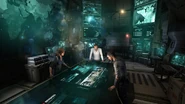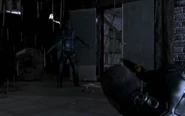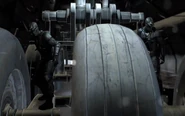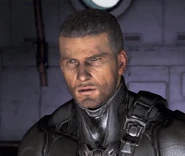(→Trivia: correction of grammar, names, and information) Tag: Visual edit |
Tag: Visual edit |
||
| Line 23: | Line 23: | ||
The National Security Agency created Second Echelon, which focused entirely on this new breed of communications technology. Unfortunately, the immense volume of information combined with the accelerated pace of developing technology and encryption overwhelmed Second Echelon. NSA experienced its first system-wide crash. |
The National Security Agency created Second Echelon, which focused entirely on this new breed of communications technology. Unfortunately, the immense volume of information combined with the accelerated pace of developing technology and encryption overwhelmed Second Echelon. NSA experienced its first system-wide crash. |
||
| − | As communications became more digital and sophisticated encryption became more expansive, passive collection simply was rendered inefficient. To address this, the NSA launched a top-secret initiative in 2003. Hoping to bridge the chasm between simply gathering actionable intelligence and acting on that intelligence, the NSA was directed by special Presidential charter to form Third Echelon, its own in-house covert operations unit created specifically to physically obtain intelligence in locations where all other means were exhausted. Third Echelon was disbanded in |
+ | As communications became more digital and sophisticated encryption became more expansive, passive collection simply was rendered inefficient. To address this, the NSA launched a top-secret initiative in 2003. Hoping to bridge the chasm between simply gathering actionable intelligence and acting on that intelligence, the NSA was directed by special Presidential charter to form Third Echelon, its own in-house covert operations unit created specifically to physically obtain intelligence in locations where all other means were exhausted. Third Echelon was disbanded in 2011 following the [[Third Echelon Conspiracy]]. |
Fourth Echelon was formed after Third Echelon was dissolved, created a brand new initiative that reports directly to the President of the United States. |
Fourth Echelon was formed after Third Echelon was dissolved, created a brand new initiative that reports directly to the President of the United States. |
||
Revision as of 03:42, 28 December 2014
Template:Infobox unit
Fourth Echelon (also known as 4th Echelon, abbreviated as 4E) is a "blacker than black" clandestine special operations and counter-terrorism unit that answers solely to the President of the United States. Commissioned by President Patricia Caldwell, the unit is mandated to deal with terrorist threats to U.S. interests.
Overview
The unit's commander is former Third Echelon Splinter Cell Sam Fisher, who was instrumental in foiling an assassination attempt on President Caldwell orchestrated by the rogue Third Echelon director Tom Reed. Former Third Echelon chief technical advisor Anna Grímsdóttir, who previously worked closely with Fisher when he was with Third Echelon, serves as the unit's technical operations control officer. Added to the unit are former CIA agent and new 4E operative Isaac Briggs and computer hacker Charlie Cole, while Andriy Kobin becomes a source of intelligence inside holding cell. The unit has no permanent ground base. It operates out of the Paladin, a large military transport aircraft repurposed as a stealth airliner for their mobile headquarters.
Background
The National Security Agency is the signals intelligence (SIGINT) and cryptologic establishment of the United States. Primarily tasked with the conduct of SIGINT in all its forms, the NSA can and does intercept and analyze every form of communication known to man, from cellphone signals and e-mail messages, to microwave emissions, to ELF (Extremely Low Frequency) burst transmissions from submarines thousands of feet beneath the surface of the ocean. It coordinates, directs and performs highly specialized activities to protect U.S. information systems and produce foreign intelligence reports. Since it's on the edge of communications and data processing, the National Security Agency is naturally a very high-tech operation. For decades, the NSA has engaged in the 'passive' collection of moving data by intercepting communications en route.
The First Echelon was a worldwide network of international intelligence agencies and interceptors that seized communications signals and routed them back to the NSA for analysis. It was a network vital to the United States' efforts during the Cold War. As the Soviet Union disintegrated and communications evolved, high technology became the name of the game.
The National Security Agency created Second Echelon, which focused entirely on this new breed of communications technology. Unfortunately, the immense volume of information combined with the accelerated pace of developing technology and encryption overwhelmed Second Echelon. NSA experienced its first system-wide crash.
As communications became more digital and sophisticated encryption became more expansive, passive collection simply was rendered inefficient. To address this, the NSA launched a top-secret initiative in 2003. Hoping to bridge the chasm between simply gathering actionable intelligence and acting on that intelligence, the NSA was directed by special Presidential charter to form Third Echelon, its own in-house covert operations unit created specifically to physically obtain intelligence in locations where all other means were exhausted. Third Echelon was disbanded in 2011 following the Third Echelon Conspiracy.
Fourth Echelon was formed after Third Echelon was dissolved, created a brand new initiative that reports directly to the President of the United States.
Personnel
Fourth Echelon's members are specialists from various backgrounds and military areas, including the CIA, civilian life, former Third Echelon members and even some who were from a PMC.
- Sam Fisher - Commander/Field Operative
- Anna Grímsdóttir - Technical Operations Officer/Second-in Command
- Charlie Cole - Computer hacker/Technology Officer
- Isaac Briggs - Field Operative
- Andriy Kobin - Captive/Source of Intelligence/Spare pilot
- Analysts
- Pilots
- Unidentified pilot
- Unidentified co-pilot
- Unidentified loadmaster
Base of Operations
See: C-147B Paladin
Operations
2013: Blacklist Attacks
Full article: Tom Clancy's Splinter Cell: Blacklist
Fourth Echelon's first assignment was the disruption of a planned terrorist action of escalating attacks against United States interests, known as The Blacklist. The Blacklist was orchestrated by a newly formed group of terrorists called The Engineers. The Engineers sought to not only repel the United States from foreign ground, but to also shut down elements of Fourth Echelon by targeting them directly. During the Blacklist Attack, Fourth Echelon deployed the Spider-Bot to gather intelligence.
Post-Blacklist
Full article: Tom Clancy's Splinter Cell: Blacklist Aftermath
After foiling the Blacklist attacks, the team returned to operational status. Their next mission was to hunt down rogue agents who had stolen 100 pounds of Uranium from Russia. Fisher chased their leader, who died in an accident. They were pulled from it to extract computer programmer Igor Kasperov. Next they rescued his daughter from the "Snow Maiden" and pulled him from Peru. Fourth Echelon then stopped the Russian oligarchies' plan to blow up a Saudi oil refinery with a nuclear weapon.
Appearances
- Tom Clancy's Splinter Cell: Blacklist
- Splinter Cell Blacklist Spider-Bot
- Tom Clancy's Splinter Cell: Blacklist Aftermath
Trivia
- Fourth Echelon was formed after Third Echelon was dissolved during the Third Echelon Conspiracy; their logo remains similar to the previous but has slight changes such as the outer shape and star placement.
- Currently, the Fourth Echelon is much smaller than Third Echelon. The only known 4E Splinter Cell operatives are Sam Fisher and Isaac Briggs.








